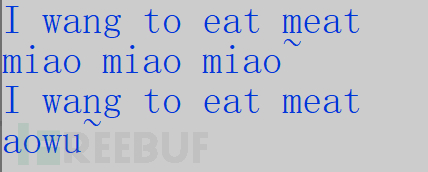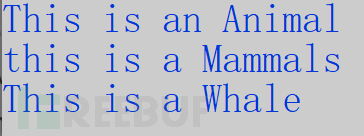 JaQLine
JaQLine- 关注
 本文由
JaQLine 创作,已纳入「FreeBuf原创奖励计划」,未授权禁止转载
本文由
JaQLine 创作,已纳入「FreeBuf原创奖励计划」,未授权禁止转载
学到了多态了,C++的多态就是让你领悟指针之美的地方
虚函数
之前我们说一个对象调用成员函数是根据作用域来调用的,这其实不够严谨。在多态这边,我们运用到了虚函数,在这里函数的调用就和指针有关了。
虚函数就是在成员函数前面加一个virtual关键字。我们来看一下代码
#include <iostream>
using namespace std;
class A
{
public:
A();
virtual void func();
};
A::A(){}
void A::func()
{
cout << "this is A Func" << endl;
}
class B:public A
{
public:
B();
void func();
};
B::B(){}
void B::func()
{
cout << "this is B Func" << endl;
}
int main()
{
A *a = new B();
a->func();
}
然后我们来看输出
我们之前已经了解过,如果不加virtual关键字,a输出的应该是A的函数,但是加了virtual以后调用了B的函数。
前面我们也提到过成员函数的名字遮蔽,但是没有细说,在这里详细的讲一下。和变量名遮盖比较像,我们这次专门比较一下参数对函数调用的影响。
#include <iostream>
using namespace std;
class A
{
public:
A();
void func();
};
A::A(){}
void A::func()
{
cout << "this is A Func" << endl;
}
class B:public A
{
public:
B();
// void func();
};
B::B(){}
//void B::func()
//{
// cout << "this is B Func" << endl;
//}
int main()
{
B *b = new B();
b->func();
}
首先运行一下这个代码,运行结果
然后我们把注释的地方加上
发生了名字遮蔽,现在运行的是B的成员函数。我们再做一个小小的改变,在声明定义B的func函数的时候加上参数
#include <iostream>
using namespace std;
class A
{
public:
A();
void func();
};
A::A(){}
void A::func()
{
cout << "this is A Func" << endl;
}
class B:public A
{
public:
B();
void func(int a);
};
B::B(){}
void B::func(int a)
{
cout << "this is B Func" << endl;
}
int main()
{
B *b = new B();
b->func();
}
然后再次运行的时候发生了报错
那么我们就可以推测一下,只要B中出现了和A同名的成员函数,不管函数的参数列表是怎样的,都会将A的成员函数遮盖掉。
从这里我们引出了虚函数。当我们需要对函数名进行复用的时候,就用到了虚函数。用代码来举个例子
#include <iostream>
using namespace std;
class Animal
{
public:
virtual void func();
};
void Animal::func()
{
cout << "this is an animal." << endl;
}
class Dog:public Animal
{
public:
void func();
};
void Dog::func()
{
cout << "this is a dog." << endl;
}
int main()
{
Animal *dog = new Dog();
dog->func();
return 0;
}
一个很简单的例子,我们创建了animal类和dog类,当两者都需要用到func这个函数的时候virtual就起了作用。它让函数不在通过作用域来调用,实现了函数名的复用
虚函数基于函数名的遮盖,那么这个函数名的遮盖有什么特点吗?我们可以写代码来实现一下
#include <iostream>
using namespace std;
class Animal
{
public:
virtual void func();
virtual void func(int a);
};
void Animal::func()
{
cout << "this is an animal." << endl;
}
void Animal::func(int a)
{
cout << "this is int of Animal" << endl;
}
class Dog:public Animal
{
public:
void func();
void func(string name); //可以尝试把string name改成int a,int b
};
void Dog::func()
{
cout << "this is a dog." << endl;
}
void Dog::func(string name) //可以尝试把string name改成int a,int b
{
cout << "this is a string func of dog" <<endl;
}
int main()
{
Animal *dog = new Dog();
dog->func();
dog->func(5);
// dog->func("qwe");
//也可以换成两个数字作为参数
//前面这一句会发生报错
return 0;
}

代码中我们标记了几个会发生报错的地方,报错内容都是
我们得出结论,派生类中但凡出现了名字遮盖,在基类中都需要有定义。尤其应该注意参数列表。
纯虚函数
我们只需要在虚函数后面加个=0就可以了。virtual type funcname()=0。纯虚函数只需要声明不需要定义,具体的定义交给派生类。只要有一个纯虚函数,定义的类就被称为抽象类。抽象类不能被实例化。
这个感觉就有点像Java里的接口了,抽象类不仅有了虚函数中名称复用的特点,还有了Java里面接口的功能。直接看一个代码
#include <iostream>
using namespace std;
class Animal
{
public:
virtual void eat() = 0;
virtual void speak() = 0;
};
class Cat_Family:public Animal
{
public:
void eat();
};
void Cat_Family::eat()
{
cout << "I wang to eat meat" << endl;
}
class Cat:public Cat_Family
{
public:
void speak();
};
void Cat::speak()
{
cout << "miao miao miao~" << endl;
}
class Tiger:public Cat_Family
{
public:
void speak();
};
void Tiger::speak()
{
cout << "aowu~" << endl;
}
int main()
{
Animal *cat = new Cat();
Animal *tiger = new Tiger();
cat->eat();
cat->speak();
tiger->eat();
tiger->speak();
return 0;
}
我们定义了动物类、猫科类、猫类和老虎类。其中动物类有两个纯虚函数,所以是一个抽象类。然后猫科类继承了动物类,但是只实现了一个纯虚函数,另外一个纯虚函数被继承了下来,所以猫科类也是一个抽象类。然后老虎类和猫类分别实现了speak函数
如何实现?
我们说过虚函数是通过指针进行的调用,那么具体是如何实现的?这里用到了虚函数表。之前我们学习过虚基类,是把基类的成员变量进行共享;这里的虚函数其实是把函数名进行共享,并且用到了虚函数表。
我们先来写一下代码
#include <iostream>
using namespace std;
class Animal
{
public:
Animal(int age,int big);
virtual void what();
virtual void food();
protected:
int m_age;
int m_big;
};
Animal::Animal(int age,int big):m_age(age),m_big(big){}
void Animal::food()
{
cout << "I want to eat everything" << endl;
}
void Animal::what()
{
cout << "This is an Animal" <<endl;
}
class Mammals:public Animal
{
public:
Mammals(int age,int big,int speed);
virtual void what();
virtual void eat();
protected:
int m_speed;
};
Mammals::Mammals(int age,int big,int speed):Animal(age,big),m_speed(speed){}
void Mammals::what()
{
cout << "this is a Mammals" << endl;
}
void Mammals::eat()
{
cout << "I will eat Fish" << endl;
}
class Whale:public Mammals
{
public:
Whale(int age,int big,int speed);
virtual void what();
virtual void hobby();
};
Whale::Whale(int age,int big,int speed):Mammals(age,big,speed){}
void Whale::what()
{
cout << "This is a Whale" << endl;
}
void Whale::hobby()
{
cout << "I can swim" << endl;
}
int main()
{
Animal *a = new Animal(5,50);
a->what();
a = new Mammals(6,60,600);
a->what();
a = new Whale(7,70,700);
a->what();
}
一个比较简单的代码,然后我们来看一下运行结果
但是我们如果加上这么几句
int main()
{
Animal *a = new Animal(5,50);
a->what();
a = new Mammals(6,60,600);
a->eat();
a->what();
a = new Whale(7,70,700);
a->hobby();
a->what();
}

这时发生了报错。当我们进行实例化的时候,会在成员变量的正上方,也就是第一个成员变量的相邻低地址处增加一个虚函数指针,这个虚函数指针会指向虚函数表。

就像这样,Animal的对象的顶部有一个虚函数表指针,指向了虚函数表的首地址。而它的派生类,如果有同名遮盖的函数名,则会在原位置进行遮盖;新增的函数则会放到最下面,就像下图
同理可得Whale类对象的内存结构
有了这样的内存结构,编译器进行编译的时候会很方便,遵循一个公式,假设对象的头指针为p:* (*(p+0)+x)(参数列表),其中x代表虚函数表距离头指针的偏移。
到这里虚函数就结束了,不过还是要记住,对象的访问一定是遵循只能访问该访问的,前面的报错就是因为我们明明是Animal类型却想要访问其它类型的成员函数!
如需授权、对文章有疑问或需删除稿件,请联系 FreeBuf 客服小蜜蜂(微信:freebee1024)
 Linux系统编程
Linux系统编程










